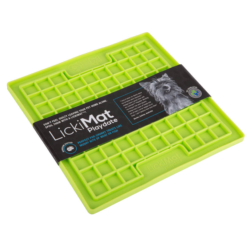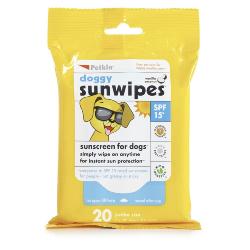  Dogs can suffer fatal heatstroke within a very short period of time, potentially within minutes of exposure to extreme heat such as that seen during heatwaves in the UK & Ireland. Unlike humans, dogs can’t sweat through their skin. Instead they rely on panting and releasing heat through their paw pads and nose to regulate their body temperature and keep cool.
While almost any dog can tolerate the hot summer months with appropriate hydration and environment management, some dogs will have a much harder time enjoying the heat than others.
Snub-nosed, brachycephalic dogs have a harder time regulating their temperatures due to their shorter nasal passages. English Bulldogs, French Bulldogs, Pugs, and Boston Terriers are more sensitive to rising temperatures than dogs with thin, short coats, dogs originating from hot climates and those bred for high-speed, such as sighthounds. Other dogs that need special attention during a heat wave include giant breed dogs, especially those with thick, double coats, as well as very young, elderly, obese or diabetic animals.
Dogs can only sweat from their paws, so they do not cool down like humans who sweat from all over their body. Panting is a cooling method for dogs, but this can leave them severely dehydrated.
 Even when the sun is beaming down, many dogs still need their daily walk - a chance to explore their outdoor environment and exercise their minds as well as their bodies. However, there are a few things we can do to keep our pets as safe as possible when exercising in warmer weather.
Walks should take place early in the morning or late in the evening, not during periods of direct and intense sunlight. You may need to take a shorter walk than usual, and avoid playing fetch which may cause your dog to overexert. In very hot, humid weather, never exercise dogs by cycling while they try to keep up or by running them while you jog. Dogs will often collapse before giving up, in an attempt to please their owner, at which point it may be too late to save them.
Dogs’ footpads easily burn on roads, pavements, artificial grass and sand which have been heated up by direct sunlight. Test the road surface with your hand before walking a dog while the sun is out. If it is uncomfortable for you to comfortably hold the back of your hand on the surface, it could potentially cause burns to your pet's feet.
Swimming provides excellent exercise for dogs and a great exercise alternative to walking in the summer heat. Be wary of currents in rivers and tides at the beach which can easily sweep a dog away and lead to drowning, particularly in dogs who are already tired from exercising in the heat.
Check freshwater lakes, rivers, ponds and canals to make sure they are clean before letting your dog dive in. Some types of algae, including blue-green algae, are toxic to dogs. If your dog swims in algae-contaminated water, contact your vet immediately. Ideally you should carry water from your home to provide hydration throughout the walk, as drinking salt water at the beach is likely to make your dog sick and water from rivers can contain harmful pollutants and plants.
Water intoxication occurs when dogs swallow too much water in a short space of time. It’s rare, but this condition can lead to brain damage and, in extreme circumstances, can be fatal. Dogs can sometimes swallow too much water when they are swimming, so it’s key that you keep an eye on them when you’re treating them to a cool off. Symptoms include vomiting, loss of coordination, tiredness, pale gums and bloating of the stomach.
Take your dog out of the water and allow them to relax every 10 minutes or so, and keep a close eye for excessive swallowing of water.
Walks are generally safe in temperatures of up to 19°C (68°F) but be careful when temperatures rise above this as even at temperatures as low as 20°C (70°F) dogs are at risk of heat stroke. Don't let your pet get sunburnt – use a non-toxic, pet safe Sun Cream on exposed parts of their skin such as the tips of their ears and nose and avoid direct sunlight where you can. This is especially important if your dog has white or light coloured fur as they can be very vulnerable to getting burnt.
Cooling Coats are ideal for use during and after exercise, but care must be taken to ensure that they are damp when being worn by the dog, to prevent an accidental heating effect. Ancol Cooling Coats come complete with a waterproof bag for transporting the coat after wetting, perfect to keep in your car for the journey home from the park!
 While keeping your dog at home during heatwaves is often the best course of action, it is important not to assume that your home will be cool enough to keep your dog safe. Dogs who are overweight, elderly, brachycephalic or those with thick coats of fur may struggle even in shaded areas of the home.
If you have a very hairy or fluffy dog, ensure that they are well groomed and free from tangles and impacted undercoat. A coat in good condition provides a built in air conditioning system to the dog's body, as air can travel freely throughout the dog;s hair and make contact with the skin to help keep it cool. If you are unsure of how to correctly groom your dog's coat for maximum safety and comfort in warmer weather, check out our Dog Grooming Guides for your dog's individual coat type and consult with a dog groomer if needed. Check around the bottom of particularly fluffy, elderly, obese or matted animals regularly for signs of fly strike, and seek veterinary advice immediately if you think your pet may be affected.
Ensure your dog has a cool, shaded area to relax, both inside and outside your home, as some dogs worry about missing out on activities in the garden so may not want to stay inside when the family are enjoying the outdoors. Make use of Cooling Mats within the shaded relax areas to provide instant cooling when your dog makes contact with the mat. A damp towel or an ice pack wrapped in a towel will also provide a shorter term cooling effect for your dog but should be refreshed regularly.
Fresh drinking water should be readily available at all times, in various areas around your home and garden if needed for easy accessibility. A few ice cubes added to the bowl every hour or so can provide entertainment, encourage the dog to the water bowl and keeps the water cool. Water should be changed regularly throughout the day. Rock Sulphur, a rock from which natural minerals will disperse through the dog's drinking water to ensure every sip is fresh and beneficial to your dog's health, can be added to the bowl as a traditional remedy to prevent overheating.
 Heatstroke can make a previously healthy dog seriously ill within less than 15 minutes and the chance of survival, even with veterinary intervention, is only around 50%. While it is certainly a case where prevention is better than cure, knowing the signs which indicate a dog is affected will allow you to get immediate veterinary attention is you think your dog may have heat stroke.
Symptoms of heatstroke are varied and some dogs will only exhibit a few signs, even when damage is being ravished upon their internal organs. Signs include excessive panting and drooling, a bright red tongue or gums, dehydration, a temperature above 39°C (103°F), a rapid or irregular heart beat, shock, sudden breathing distress, seizures or muscle tremors, bloody stools which may appear black and tarry, lack of urination, dehydration, small, pinpoint areas of bleeding or bruising, a wobbly gait and unconsciousness.
If you think your dog may be suffering from heatstroke, immediate veterinary treatment will be imperative to survival. Phone your veterinary clinic to alert them that you are incoming with a potential heatstroke case, so that they can be prepared and ready to treat your pet immediately. Enroute to the vets, keep cool air circulating around the dog and give small and regular amounts of water if the dog is conscious. The dog should also be soaked in room temperature water. For the best chance of survival, dogs suffering from heatstroke urgently need to have their body temperature lowered, but this needs to be done gradually or they can go into shock.
Treatment will probably include fluids and minerals replacement. Your vet will be able to identify any secondary conditions the heatstroke may have caused. Complications such as kidney failure, development of neurologic symptoms, abnormal clotting, changes in blood pressure, and electrolytes abnormalities are typically observed in cases of heatstroke. Dogs with just moderate heatstroke often recover without complications. Severe heatstroke can cause temporary or permanent organ damage, and death.
 Longer journeys in warm weather should be avoided where possible, especially for dogs who are more prone to overheating and struggle in the heat.
If you're planning a day out, check whether dogs are welcome at the visitor attractions you plan to visit. Some public parks and beaches may have Public Space Protection Orders or Dog Control Orders in place during certain times of year, like summer, so do check before travelling. If dogs are not permitted, please make sure you arrange for a pet sitter or kennels or choose a dog-friendly alternative attraction.
If possible, avoid congested roads or busy times of day when your dog could overheat in the car if you are caught up in traffic. Plan your journey considering cooler times of the day and places to take breaks for toileting and drinks.
Never leave a dog in a car, even for a moment. When it is 22°C outside, the temperature in a car can reach an unbearable 47°C within an hour.
If you see a dog in distress inside a car, official advice is to dial 999 immediately and ask for the police. A dog in distress in a hot car is an emergency and the police will advise you what to do based on the situation.
Depending on the severity of the situation, the police may attend and break into the car to gain access to the dog, or they may advise you to do this. If you decide to break into a car without proper justification, this could be classed as criminal damage and you may need to defend your actions in a court.
Call the police using 999 and tell them what you intend to do and why. Take pictures and/or videos of the dog in distress and the names and phone numbers of witnesses.
 Fleas and ticks thrive in the heat, with regular application of spot-on treatments being the only way to prevent infestations. Check out our guide to Fleas, Ticks, Lice & Mites for details on how to keep your pet safe from biting insects.
Ticks carry diseases, so it’s important to remove any that attach themselves to your dog. This can be tricky, as you need to be careful not to squeeze the tick’s body, or allow its head to get stuck inside your dog. Twisting them off your dog is the best removal method, with a Tick Removal Tool - a handy component to keep in your Dog First Aid Kit.
Dogs love to chase buzzing insects, but getting too close can be dangerous. Most insect stings will simply cause your dog pain and irritation, but multiple stings can be fatal. Dogs are also at risk when they snap at bees and wasps because this makes them more likely to be stung in the mouth or throat. Stings in these areas are hazardous because any swelling can block your pet’s airway. Some dogs are allergic to bee and wasp stings, so watch out for signs of allergic reaction, including swelling and difficulty breathing. If you think your dog has been stung multiple times, or is having an allergic reaction, take them to a vet straight away. Symptoms of a sting allergy include swelling of the mouth, face or throat, difficulty breathing and collapsing.
As a legal requirement, it's important to make sure your dog is microchipped and wearing a collar with an ID tag. ID tags legally must have enscribed the owner's name and address, with a contact number highly recommended. In the summer you're likely to be outside a lot more with your dog so they need to be identifiable should they go missing.
If your dog is used to long hikes or intense play outside, it can be difficult to keep them settled in warmer weather when such regular exercise isn't possible. Play brain games with your dog, spend time indoors teaching tricks, feed from puzzle toys such as the Kong Wobbler and provide interactive games such as the Trixie Flip Board to help tire them out.
|





